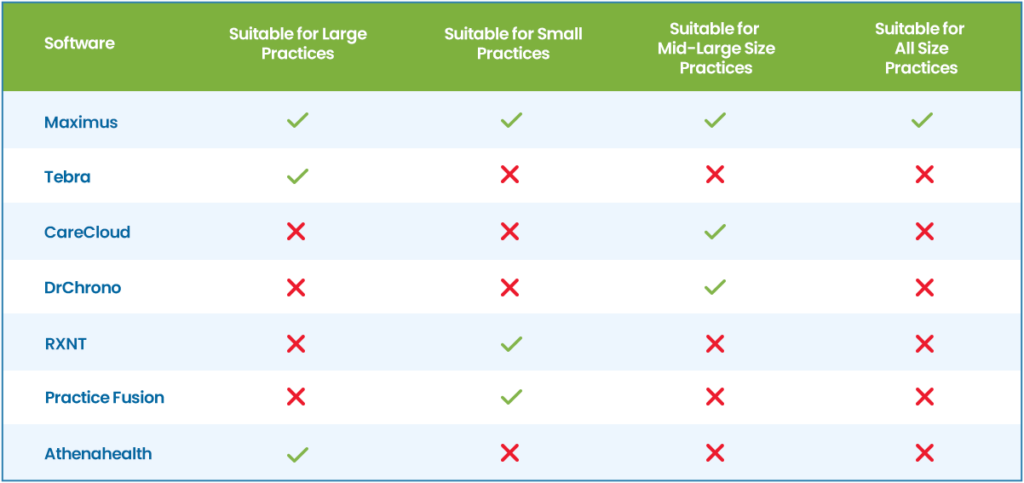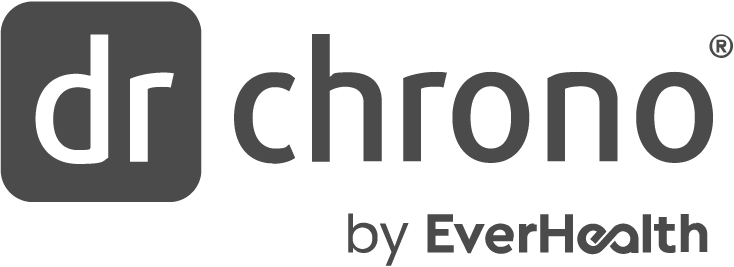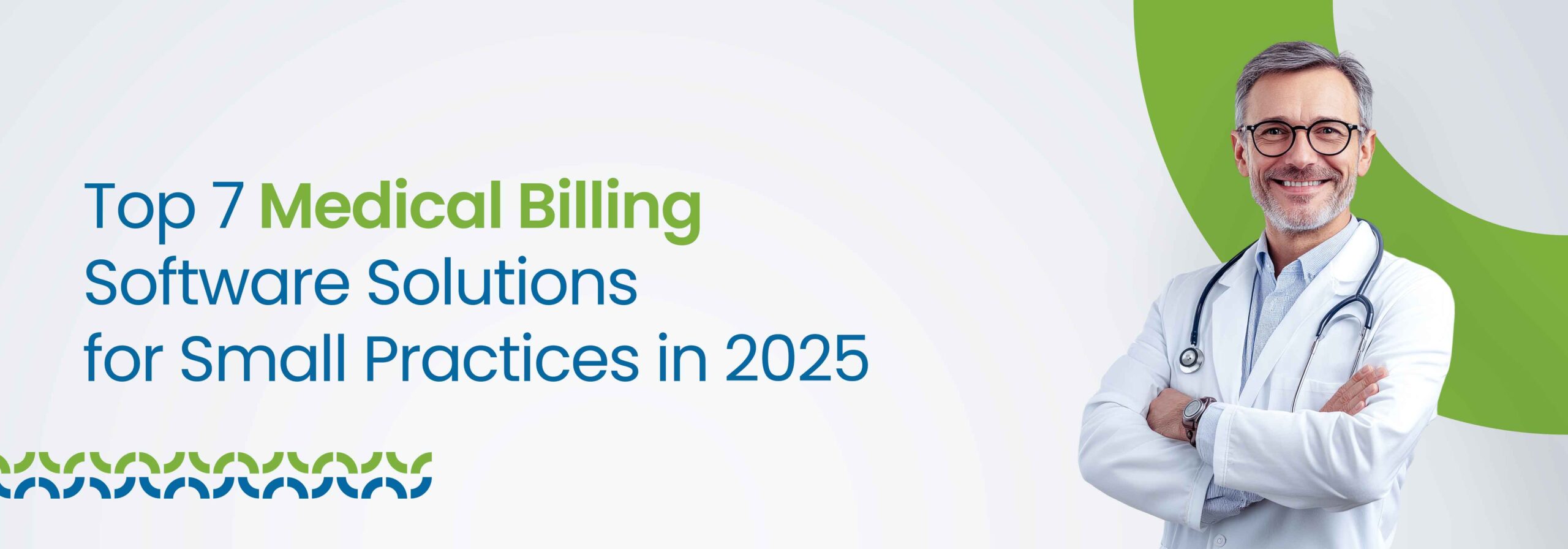Managing a small medical practice comes with its fair share of challenges. Between patient care, insurance claims, and billing, it can feel like there’s always something else demanding your attention. Billing, in particular, is one of the most time-consuming and often frustrating tasks for small practice owners.
Effective management of accounts receivables is crucial for healthcare providers to streamline their financial aspects and improve cash flow.
With the right medical billing software, you can streamline your billing processes, reduce errors, and speed up your collections—all while keeping costs low and maintaining control of your practice’s financial operations.
In this blog, we will take a closer look at some of the top medical billing software for small practices that can streamline your billing process, improve efficiency, and eliminate the frustrations of manual billing.
Key Takeaways
- Medical billing software streamlines billing and administrative tasks for healthcare professionals.
- It automates insurance eligibility checks, generates patient statements, tracks payment statuses, and posts payments to patient accounts, saving time and reducing administrative burden.
- The software also minimizes manual entry errors, ensuring greater accuracy in billing.
- These solutions integrate easily with most ERP or CRM systems.
Benefits of Billing Software
Billing software has many benefits that can really help with revenue cycle management for healthcare providers. By streamlining the billing process and reducing errors billing software helps providers run more efficiently.
One of the biggest benefits of billing software is automation of tasks like claim submission, payment processing and patient statement generation. Automation saves time and reduces errors so claims get processed accurately and quickly.
Billing software also helps providers manage their patient accounts better, reduce bad debt and improve cash flow. With real time updates on claim status and payment processing providers can stay on top of their revenue cycle and get timely payments.
Plus billing software enhances patient engagement and experience by giving patients easy access to their medical records and billing information. Transparency builds trust and improves patient satisfaction.
By reducing administrative tasks billing software lets providers focus more on patient care. And the software gives providers valuable insights into practice operations so they can identify areas to improve and optimize their revenue cycle.
Implementing billing software can lead to overall efficiency and cost savings and ultimately more revenue and profit for providers. In summary billing software is a must have for providers looking to improve their revenue cycle and patient care.
How to Choose the Best Medical Billing Software for Your Small Practice
Selecting the right medical billing software for small practices can be a tough decision, given the wide range of options on the market. Here are a few tips to guide you in making an informed choice:
Step 1: Map Out Your Billing Workflow
Start with how your practice currently handles billing:
- Who enters charges?
- How are claims submitted and followed up?
- Is billing done in-house or outsourced?
- Are you working with billing companies or managing billing internally?
Understanding your workflow helps you find software that fits your process, not the other way around.
Step 2: Identify Gaps and Challenges
Ask your team:
- Where do delays or errors happen most?
- Are denials increasing?
- Do you lack visibility into collections?
These gaps show you what features to prioritize—like better denial tracking, scrubbers, or real-time reporting. Incorporating advanced analytics can further enhance these features by streamlining workflows through improved claim scrubbing, coding, and denial resolution.
Step 3: Decide on Deployment: Cloud-Based vs. On-Premise
- Cloud-based systems are easier to access, update automatically, and often cost less up front.
- On-premise systems give you more control but require IT support and hardware.
Pick based on your team’s familiarity with technology and the infrastructure you already have.
Step 4: Shortlist Software That Matches Your Needs
Now you can start comparing. Look for:
- Clean, easy-to-use interface
- Integration with your EHR and PMS
- Custom rules for payers and specialties
- Built-in clearinghouse or easy claim submission
- Transparent pricing
Pro tip: avoid systems that lock you into long contracts without a trial.
Step 5: Schedule a Live Demo with Your Billing Staff
A flashy demo doesn’t mean it works in real scenarios. Involve the people who actually use the software—billers, front desk, coders. Let them ask:
- How fast is the claim entry?
- Can they track claims easily?
- How are patient balances handled?
This step helps avoid surprises later.
Step 6: Check Support, Onboarding, and Training
Don’t skip this. Even great software is frustrating if the support is slow or training is weak. Make sure:
- You will have a dedicated onboarding manager
- Support is available during your business hours
- They offer regular updates and training
Step 7: Test It with Real Scenarios
If possible, request a sandbox or trial version. Try:
- Entering a charge
- Submitting a test claim
- Pulling a report
Does it feel smooth or clunky? Does it work the way your team expects?
Step 8: Compare Costs—And Value
Understand the full pricing:
- Setup or training fees
- Monthly or per-provider charges
- Clearinghouse costs
- Contract terms
But also look at ROI: Will it reduce claim errors, shorten your AR, or improve collections?
Step 9: Read Case Studies or Ask for Referrals
Look for real-world examples—especially in your specialty. Reach out to a few users and ask how it’s helped them, and if they would still choose it today.
Step 10: Make a Confident Choice
Now you have done the legwork—choose the platform that:
- Matches your workflow
- Solves your actual billing problems
- Offers support when you need it
- Grows with your practice
The 7 Best Medical Billing Software for Small Practices in 2025
Now that you know how to choose the right medical billing software for your small practice, let’s look at some of the best systems available. We will cover the pros and cons of each one, so you can easily decide which is the right fit for your needs. (Note: While there are many options on the market, we have highlighted the top ones below.) Medical office software offers comprehensive solutions that streamline and automate various administrative and financial processes, enhancing efficiency and profitability.
Which Software Works Best for Your Practice Size?

Let’s take a closer look at each software’s features to help you understand them better. This will also help you determine which software is best suited for different practice sizes.
1. Maximus

Backed by a decade of experience and developed by industry experts, Maximus is a cloud-based, scalable medical billing and practice management system designed for small, mid-size, and large practices. It enhances operational efficiency and intelligently helps you collect payments faster. With an affordable pricing structure and all the essential HIPAA-compliant features, it’s a perfect fit for your practice in 2025. Here’s why:
| Pros for small practices | Cons for small practices |
|---|---|
| Cloud-Based Data Management: Secure cloud storage with remote access, ensuring continuity and security of patient and practice data. | Not an EHR System: As it is a medical billing and practice management software, it may not meet the needs of practices specifically looking for an integrated EHR solution. |
| Automated Billing & Coding: Automates billing processes, reduces coding errors, and speeds up claim submissions for faster reimbursements. | |
| Eligibility Verification (Pre-Appointment): Automates insurance eligibility checks before appointments, reducing claim denials. | |
| AR Management & Denial Resolution:Streamlines accounts receivables management and automates denial resolution to improve cash flow and reduce write-offs. | |
| BI Reporting & Analytics: Provides financial and operational reports for better decision-making. | |
| Integrated APIs & System Interoperability: Integrates effortlessly with EHRs, billing systems, and telemedicine tools. | |
| Patient Portal: Enables secure online payments, access to health records, and out-of-pocket costs via EDI 271 responses. | |
| Specialty-Specific Billing Support: Supports billing for over 50 specialties, making it suitable for various healthcare practices. |
2. Tebra

Tebra is an EHR platform that helps medical practices manage everything in one place. When it comes to billing and payments, tebra makes the process easier by combining practice management, insurance checks, claims handling, and patient payments. But according to reports, it might NOT be a good match for single practitioners or small clinics with limited needs. We have also listed an analysis of its pros and cons below, with credible reference links, so it might be easier for you to decide.
| Pros for Small Practices | Cons for small practices |
|---|---|
| All-in-One Features: Includes EHR, billing, telehealth, and patient tools—everything in one place. | Customer Support Problems: Some users report slow or unhelpful service. |
| Time-Saving Tools: Custom templates and shortcuts speed up charting and scheduling. | Glitches: Occasional technical issues can disrupt workflow. |
| Telehealth Ready: Built-in telehealth lets patients get care from anywhere. | |
| Access Anywhere: Cloud-based system gives providers flexibility to work from any location. | . |
| Easy to Use: Clean, intuitive design makes it simple for staff to navigate. |
3. CareCloud

CareCloud offers a comprehensive, cloud-based medical billing software designed to enhance the reimbursement cycle for medical practices. This solution is particularly beneficial for the healthcare industry, as it addresses specific challenges and aims to improve patient care and streamline services.
Here are the pros and cons, so it might be easier for you to decide whether to use this medical billing software for your small practice:
| Pros for Small Practices | Cons for small practices |
|---|---|
| Automation: Speeds up billing and payments while reducing errors. | High Cost: May be too expensive for smaller practices |
| Financial Reports: Clear reports help with smarter financial decisions. | Integration Issues: Can be hard to connect with other financial tools. |
| Efficient Operations: Automates revenue tasks to keep finances on track. | Learning Curve: It may take time to understand and use the reports and analytics effectively. |
| Transparent Pricing: Monthly pricing makes budgeting easier. | Setup Fees: Setup, training, and implementation fees are higher than most competitors. |
| All-in-One Management: Combines billing and practice management in one system. | Long Contracts: Requires at least a one-year commitment, often longer. |
| Easy Scheduling: Drag-and-drop calendar makes scheduling quick and simple. |
4. DrChrono

DrChrono helps healthcare organizations optimize their workflow by automating patient documentation, scheduling, payments, and analytics. It also includes integrated e-prescribing and secure messaging features.
However, you should consider potential limits in customization, device compatibility, and support when deciding if it’s right for your small practice:
| Pros for Small Practices | Cons for small practices |
|---|---|
| Mobile Capabilities: Strong mobile features, ideal for remote or on-the-go care. | Cost: Higher-tier plans may be costly for solo or small group providers. |
| Integrated Billing + EHR Systems: Both billing and EHR systems in one platform for better efficiency and streamlined operations. | iOS-Centric: Heavily iOS-focused, not ideal for Android users. |
| Specialty Customizations: Tailored features specific to different specialties. | Offline Functionality: Limited offline options compared to competitors. |
| User Interface: Easy-to-use interface that simplifies workflow. | |
| Apple Mobility Partnership: Strong iOS ecosystem support as an Apple Mobility Partner. |
5. RXNT

RXNT is an easy-to-use practice management system designed for outpatient care providers. It offers features like automated insurance eligibility checks, claims processing, patient billing, collections tracking, integrated SMS reminders, and more. It is also highly suitable and affordable for private practitioners and small practices.
Below is an analysis of its features, along with the pros and cons for small practices:
| Pros for small practices | Cons for small practices |
|---|---|
| Affordability: Affordable pricing starts at $110/month with free setup, training, support, and updates. | Claim Limitations: Basic plan limits claims to 50 per month; higher volumes need an upgrade. |
| Integrated E-Prescribing: E-Prescribing allows sending prescriptions directly to pharmacies. | Learning Curve: Some users find the interface difficult to use at first. |
| Mobile Accessibility: Cloud-based with iOS and Android apps for mobile access. | Customer Support Limitations: Limited customer support hours. |
| Comprehensive Features: Offers RCM, scheduling, and a patient portal in one system. | System Performance Issues: Users report occasional slowness and glitches. |
| Regular Updates: Regular updates ensure compliance and new features. | Integration Challenges: Integration with existing workflows can be challenging. |
6. Practice Fusion

Practice Fusion is a cloud-based EHR system designed for small to medium-sized practices. It helps improve clinical workflows and patient care with various features:
| Pros for small practices | Cons for small practices |
|---|---|
| User-Friendly: Easy to set up | Customer Support: Long wait times and limited live support. |
| Affordable: Cost-effective, making it suitable for small practices with limited budgets. | Limited Features: Lacks advanced features for some high-complexity specialties. |
| Cloud-Based: Can be accessed from multiple devices, providing flexibility. | Integration Issues: Some users report difficulties integrating with other systems. |
| e-Prescribing & Lab Integration: Easy prescription management and lab result tracking. | Maintenance Downtime: Scheduled updates may occasionally interrupt practice operations. |
7. Athenahealth

Athenahealth’s billing software makes it easier to manage claims, coding, and payments. It checks claims for errors, follows up on unpaid ones, and helps you get paid faster. It also works smoothly with their EHR and other tools, so you can see everything in one place.
Analyze the following facts about Athenahealth to decide whether it’s a good choice for your small practice:
| Pros for small practices | Cons for small practices |
|---|---|
| Cloud-Based Accessibility: Being cloud-based, Athenahealth enables access to patient data from any location with an internet connection. | Cost Considerations: The ongoing costs for Athenahealth’s services can be significant, especially when utilizing comprehensive billing and practice management features. |
| Integrated Billing and Practice Management: The software combines billing and practice management functions. | Feature Overload: Certain advanced features may not be fully needed for smaller practices. |
| Consultation Services: Helps optimize operations through consultations. | User Interface Challenges: Some users find the software’s interface less intuitive. |
| Keep You Informed: Offers customizable reports and analytics to track financial performance. | |
| Precise Billing: Strong support for insurance claims and billing. |
Factors to Consider when Choosing a Medical Billing Software
It’s important to understand what factors to look for in a medical billing software: ease of use, scalability, HIPAA compliance & more.
Specialty-Specific Features
Not all billing systems are created equal. Choose one that supports your specialty—whether it’s cardiology, behavioral health, or radiology. Specialty-specific codes, templates, and workflows save time and reduce errors.
Ease of Use
A complex system slows your team down. Look for an intuitive interface with easy navigation, customizable dashboards, and minimal training requirements. A clean layout helps reduce admin fatigue and speeds up onboarding.
Claims Management Capabilities
The system should handle:
- Automated claim scrubbing
- Real-time eligibility verification
- Status tracking
- Denial alerts
- Resubmission workflows
This ensures fewer delays and a faster reimbursement cycle.
Integration with EHR and PMS
EHR and PMS work together smoothly, so you don’t have to enter the same data twice. Everything from scheduling to billing to charting flows in one system.
Compliance and Security
Ensure the platform is HIPAA-compliant and supports data encryption, role-based access, and audit trails. Look for systems that also stay updated with CMS rules and ICD/CPT code changes.
Reporting and Analytics
You will need access to:
- A/R reports
- Denial trends
- KPI dashboards
- Financial summaries
A good billing system turns raw data into actionable insights that help improve revenue cycle performance.
Scalability
The system should grow with your practice. Whether you are adding new locations, providers, or services—it must support that expansion without slowing down.
Customer Support
24/7 or extended-hours support, quick response times, and knowledgeable agents matter. Choose a vendor with a strong track record for resolving issues quickly.
Cost and ROI
Look at the pricing model—monthly subscription, per-claim fee, or percentage of collections. Evaluate whether the features justify the cost and how much time or revenue it can save in the long run.
Customization and Workflow Automation
Custom rules, templates, and automated reminders make your billing more efficient. The system should adapt to your workflow, not the other way around.
The Bottom Line
For small practices, medical billing software is key to managing billing operations effectively. To choose the right solution, consider your specific needs, budget, and the features that best support your practice. Research providers, read reviews from other small practices, request a demo, and make an informed decision to find the best fit for your needs.
Still have questions? Chat with us, and we will clear up any confusion or answer all your queries.
